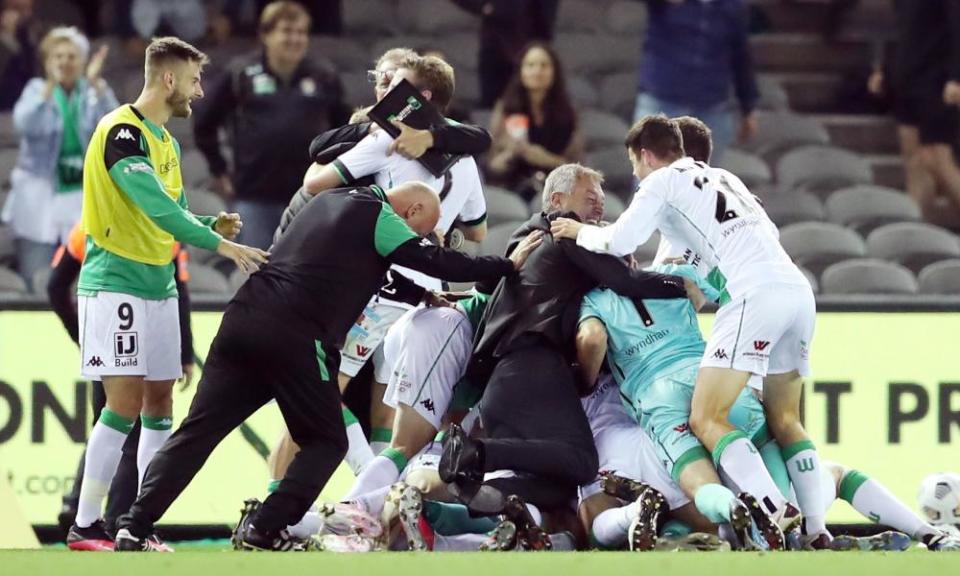A-League season continues to surprise after another thriller suspends belief

Sometimes obliviousness can occasion the unexpected. Like, while in that foggy state between asleep and awake, one pours milk into a kettle to boil some water for tea, or slips on a T-shirt inside out and travels to work. These moments, once registered, jolt us into consciousness, arouse amusement at our brief departure from reality and then curiosity about what else we may have missed while we were gone.
This is the A-League in 2021. Any viewer on Saturday may wonder if they had simply dreamed the darkness of recent seasons, and ponder whether the competition’s glory days had been cryogenically frozen and resurrected in the form of Western United’s 4-3 stoppage-time win over Melbourne Victory.
Alessandro Diamanti reconfirmed his golden oldie status. Besart Berisha was at it again with a brace. Víctor Sánchez completed his own in the 95th minute. There was a full-time stacks-on. Coach Mark Rudan got involved. That’s without even considering the eight yellow cards and one red – United played the final half-hour with 10 men.
Related: Besart Berisha: everyone's arch enemy and the A-League’s greatest ever striker | Emma Kemp
Call it fantastical, far-fetched or downright bonkers – any adjective will do. Because a season already occupying other-worldly status has just matched itself and raised it one.
The Melbourne derby came after Adelaide United beat Western Sydney 3-2, during which Craig Goodwin scored within 90 seconds of his A-League return and 16-year-old substitute Mohamed Toure netted his third for the season. The Wanderers took 19 corners to Adelaide’s none. By the end of the weekend 19 goals had been scored across five games, ensuring a record for most goals in the first 50 games of an A-League season – 150.
This season has shades of 2015-16’s semi-final and the Wanderers’ 5-4 semi-final defeat over Brisbane Roar. From 3-0 down to 4-3 up. Romeo Castelen’s hat-trick. Dario Vidosic’s extra-time winner.
Of course, that was also the start of the rot. The football continued but became a sideshow for fan boycotts, Fifa takeover threats and a style of communication resembling that of José Mourinho – rediverting responsibility and generally saying a lot of things into a camera while appearing suspiciously on the verge of meltdown. For the Tim Cahill rent-a-quote enthusiasts out there: there was no “vision”.
Attempts in recent years to engineer popularity have been numerous. The Yoshi campaign heralding the start of 2016-17 was probably the high point. A few less enamouring initiatives have been and gone – the world will be a better place if the Star Wars round is never mentioned again – and pre-season marketing has often been non-existent in a bid to avoid drowning limited funds in the dreaded AFL/NRL grand final weekend.
It may not have mattered if it did make a noise, such was the tortured soul of a game ruminating over perceived mainstream slights, real or otherwise.
The latest edition of Australian Football Eating Itself had just been sent to the printers when Covid-19 hit, and the hypothetical concept of survival became real. Some quick thinking by Football Australia chief executive James Johnson is the primary reason Fox Sports is still showing games.
By virtue of that fact, we are witnessing the most gripping season in some time. January’s game between Western United and Perth Glory was a case in point. The table is upside down and back to front. The Central Coast Mariners are first instead of last. New team Macarthur FC, under the direction of Ante Milicic, sit second after defeating defending champions Sydney FC on Sunday.
Was the off-field horror show that came before just a figment of the imagination? What next season looks like is anyone’s guess given the broadcast landscape is developing so rapidly a Sydney start-up streaming service has reportedly won the Australian rights to the Uefa Champions League. What that means for Optus, who currently owns those rights, is another unknown.
Nine, with its new streaming service, Stan Sport, has shown what it can do with rugby. That model would suit the A-League to a tee. So too does Optus. The onus to now lies with the newly formed Australian Professional Leagues who, at the turn of the year, unbundled the A-League and W-League from Football Australia and took over their operations.
What this season has proven is that, in the A-League, there is a product to be enjoyed, just as it is. Marketing is valuable when clever. That could come in the form of a high-profile campaign, but it could also be more subtle, utilising social media. It is a space in which some clubs have already had success.
Football is not the biggest code in Australia, and it may well never be. But people like parties that don’t try too hard to be cool, and if the A-League takes that on board, the public will want in.

 Yahoo Sport
Yahoo Sport 





































